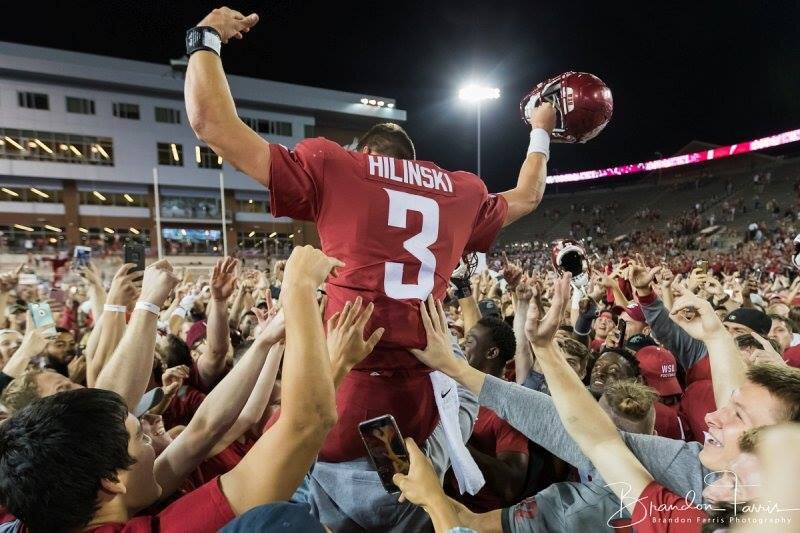April 12, 2022
Hilinski’s Hope: Spreading Mental Health Awareness In Athletes


On January 16, 2018 coaches and teammates were alarmed when Tyler Hilinski, the most dependable player on the Washington State football team, did not show up for his scheduled afternoon workout. The assistant athletic director for football operations, Antonio Huffman and Tyler’s roommate, Peyton Pueller were sent to search for his whereabouts. After searching his girlfriend’s apartment, hospitals, and contacting the police department. Pueller and Huffman kicked in the door of Tyler’s apartment after finding his car hidden in the back parking lot with a bullet hole through the door. Tyler’s roommate, Peyton Pueller, found Tyler with a bullet hole through his left eye in his closet, lying lifelessly next to an AR-15. 1
Tyler Hilinski was the middle child of three boys. From before any of them can even remember, all of the Hilinski brothers dove head first into sports. Tyler, his oldest brother Kelly, and his younger brother Ryan were always shooting hoops, throwing ball, and playing tackle. As the Hilinski boys grew older, they found themselves spending more time specializing and focusing on football. Tyler was the starting quarterback for his high school, which went undefeated his freshman year. He went on to set many records and win many awards throughout his high school career.2
Tyler was chosen by FoxSports as one of the top quarterbacks in California and was recruited by many colleges. He ended up committing to play at Washington State University after strongly connecting with head football coach Mike Leach. Tyler was described by all of his teammates and coaches as hardworking, loyal, dependable, uplifting, and relentless. His mother Kym first referred to him as “Superman” and the name stuck. Tyler always strived to live up to his nickname, but at what point did being “Superman” become too much for him? 3

Some people believe masculine sports, such as football have a surrounding stigma that you are supposed to be a little “off” mentally in order to endure the physical pain of something, such as getting tackled. In fact, it is almost glamorized the fact that athletes are to never show that they have a weakness. The top athletes are viewed as the elite of humanity and many have a false reality that they are invincible. “Mainstream outlets like Bleacher Report have farcically offered columns such as “The 10 Craziest Athletes in Sports History,” enshrining athletes for being “an enigma to sane people.” Enduring physical pain also translates to enduring mental pain, alone. For a lot of athletes, it is difficult to ask for help because that would be admitting a weakness. Tyler never let a weakness show. He was supposed to be Superman after all.4
Tyler always seemed happy and healthy to everyone around him and no one ever suspected a thing. “We have no clue what happened,” Mark said. “We will sit here for the next 20 years and not know what the heck happened to Tyler.” Upon Tyler’s death, a brain autopsy was conducted as an attempt to better see into Tyler’s mind. Results from the Mayo Clinic revealed that he had chronic traumatic encephalopathy or CTE. This is a degenerative brain condition that is caused by repeated blows to the head and head trauma. This put Tyler into two categories. He was part of a group of football players with head trauma and among the number of young people who died by suicide.5
The day that Tyler passed away, his family was contacted and no one knew of his whereabouts. His older brother Kelly realized that Tyler turned off his location on his cellphone and this began a panic. Upon Pueller finding Tyler, horror struck as Tyler’s family was notified of this terrible incident.6
Tyler’s family flew to Pullman the day after Tyler died, to attend a vigil the school put together. It was amongst this grieving that, “Kym sent Kelly a text message right then, redefining their mission, giving them a new kind of why”.
“Hilinski’s Hope,” she wrote.
“What is that?” he responded.
“Our why,” she typed back.
“Our why for what?”
“Our why for getting out of bed every morning.””

This was when it was decided that the Hikinski family would start the nonprofit Hilinski’s Hope.7 The goal of the foundation is to spread mental health awareness and education among student athletes, while eliminating stigma surrounding mental illness. The foundation also funds programs for student athletes in order to give them access to tools and resources to support themselves. Hilinski’s Hope Foundation (H3H) works directly with colleges and universities by providing resources to them and their student athletes. H3H launched College Football Mental Health Week in 2021 which is always the week of October 1-8, during Mental Health Awareness Week. In 2021, over 65 colleges participated in coming together to reduce stigma, receive resources, and have difficult conversations.8 Through the donations of vendors and partners, Hilinski’s Hope raised over $55,000 in this one week to increase accessibility and quality of resources to student athletes. In this years’ College Football Mental Health Awareness Week, October 1-8, 2022, H3H hopes to expand from last years’ 65 participating universities to 100 and 429 million media impressions to 500 million. You can sign up by filling out the form on the Hilinski’s Hope website. In order to show support to H3H, most of these participating universities’ teams wore a lime green ribbon helmet decal with a 3 to honor Tyler and show solidarity for those suffering and those that have been lost. The H3H mission has also been spread beyond football to other sports such as baseball, cheer, soccer, dance, volleyball and basketball. Most of the participating football teams also began raising three fingers for the first play of the third quarter due to Tyler being number three at Washington State University. This started at the University of South Carolina where Tyler’s younger brother Ryan was the quarterback and wore number three in remembrance of Tyler.9

In order to bring H3H to a campus, H3H has created a Hilinski’s Hope Game Plan. This is a five step plan in which H3H lays out practical tools and situations for student athletes. In this plan it gives examples of potential warning signs and behaviors that are red flags something bigger is going on. The plan goes on to explain what you, as an athlete can do and explains that talking about how you and your teammates are doing should be normalized. This plan is created in partnership with the NCAA Sports Science Institute and Prevention Strategies. To become a university partner, there are two different price levels. The $1,000 level includes: “Train-the-Trainer with Prevention Strategies, Access to our pre-recorded Tyler Talk, Facilitator Handbook, Team Training Materials, Scorecard for Self-Assessment, and Debrief with Prevention Strategies.” The $3,330 level includes all of the above except the pre-recorded Tyler Talk is a live Tyler Talk with Tyler’s parents Kym and Mark Hilinski.10
The foundation’s long term goal is to spread awareness so that mental health issues are taken as seriously physical issues. “Nobody questions an athlete taking time to recover from a sprained ankle or broken wrist. Those injuries are easy to see and come with a clear understanding that they cannot be ignored.” Possible obstacles with this is the challenge to diagnose because it’s impossible to diagnose mental illness through an X-ray or an MRI. There is so much on a student athletes’ plate such as school work, practices, competitions, pressure to perform, maintaining a good work-life balance, maintaining healthy relationships, recovery work, strength training, a possible career and more. There are barely enough hours in the day to accommodate all of these needs, and oftentimes mental issues are pushed aside as a way to show toughness and drive. By reducing stigma and providing easy access to mental health support, this will allow student athletes to juggle a days work while easily maintaining their mental health.11 Through the Hilinski’s Hope Game Plan, this can be achieved as professionals from Prevention Strategies provide mental health training to the school’s mental health professionals. From this point, conversations between student athletes and the school’s mental health professionals are started about the importance of mental health with teams, coaches, and teammates and connects students to resources while providing solutions to individual problems.12
Although Tyler is just one of many successful athletes that struggle with mental health, this is not just an issue in male sports or athletes. Tyler’s father, Mark Hilinski, stated that he had seen a good decrease in stigma around mental health thanks in part to famous athletes such as olympic gymnast, Simone Biles, and professional tennis player, Naomi Osaka, speaking out about their mental health. “That obviously brings more comfort to people when they need to talk about it,” Hilinski said. “We all want to get to the point where we don’t call someone courageous who says: ‘I’m not thinking straight. I am thinking about harming myself.’ We’ve got to get to that point.” 13
If you or someone you know is struggling, you can get involved in Hilinski’s Hope Foundation along with other foundations such as Athletes for Hope, Eric Monday Foundation, National Institute of Mental Health and many more. The National Suicide Prevention Hotline is available 24 hours, everyday and the number is 800-273-8255.
- Bishop, Greg, Mary Agnant, and Alex Agnant. “The Search for Why.” Sports Illustrated 129, no. 1 (July 2, 2018): 26–34. https://search.ebscohost.com/login.aspx?direct=true&db=f6h&AN=130362662&site=eds-live&scope=site. ↵
- “Tyler’s Story.” Hilinski’s Hope. Accessed February 3, 2022. https://www.hilinskishope.org/tylers-story. ↵
- “Tyler’s Story.” Hilinski’s Hope. Accessed February 3, 2022. https://www.hilinskishope.org/tylers-story. ↵
- Parrott, Scott, Andrew C. Billings, Nicholas Buzzelli, and Nathan Towery. “‘We All Go through It’: Media Depictions of Mental Illness Disclosures from Star Athletes DeMar DeRozan and Kevin Love.” Communication & Sport 9, no. 1 (2019): 39. https://doi.org/10.1177/2167479519852605. ↵
- Piellucci, Mike. “Suicide, Quarterbacks and the Hilinski Family – the New …” The New York Times, December 13, 2018. https://www.nytimes.com/2018/12/13/sports/football/ryan-hilinski-tyler-suicide-quarterback.html. ↵
- Bishop, Greg, Mary Agnant, and Alex Agnant. “The Search for Why.” Sports Illustrated 129, no. 1 (July 2, 2018): 26–34. https://search.ebscohost.com/login.aspx?direct=true&db=f6h&AN=130362662&site=eds-live&scope=site. ↵
- Bishop, Greg, Mary Agnant, and Alex Agnant. “The Search for Why.” Sports Illustrated 129, no. 1 (July 2, 2018): 26–34. ↵
- Maisel, Ivan. “Daily Briefing: On Crowd Noise, the ‘Hope Foundation’ and Kirk Herbstreit.” On3, October 6, 2021. https://www.on3.com/news/ivan-maisel-daily-briefing-crowd-noise-ryan-hilinski-kirk-herbstreit/. ↵
- “Tyler’s Story.” Hilinski’s Hope. Accessed February 3, 2022. https://www.hilinskishope.org/tylers-story. ↵
- “Tyler’s Story.” Hilinski’s Hope. Accessed February 3, 2022. https://www.hilinskishope.org/tylers-story. ↵
- Horton. “Athletes and Mental Health: Breaking the Stigma.” Cleveland Clinic. Cleveland Clinic, August 9, 2021. https://health.clevelandclinic.org/mental-health-in-athletes/. ↵
- “Tyler’s Story.” Hilinski’s Hope. Accessed February 3, 2022. https://www.hilinskishope.org/tylers-story. ↵
- Hanson, Scott. “Family of Former WSU Cougar Tyler Hilinski Still Pushing for Mental-Health Awareness: ‘I Think There Are Plenty of Tylers out There’.” The Seattle Times. The Seattle Times Company, October 8, 2021. ↵
Tags from the story
Recent Comments
Gisselle Baltazar-Salinas
Just to start off I really enjoyed reading your article, I found it extremely easy to read. I especially love the attention it is drawing to such an overlooked issue. I have heard of similar stories, but never knew the story of Tyler Hilinski. My heart goes out to his family! I found it to be extremely thought proking and your end with a call to action to the readers to spread the awareness!
25/04/2022
4:00 pm
Andrew Ponce
This article is very unique from the others on this page. This article not only discusses an event with a protagonist, but raises awareness within itself. The author had found a topic and wrote in a matter that keeps the reader engaged through suspense and the need to find out what happens next. Not many people understand why mental health is so important, and this article itself explains why this kind of awareness is so important. Amazing article!
26/04/2022
4:00 pm
Paula Ferradas Hiraoka
Hello Bailey, First of all, congratulations on your nomination and getting your article published! I’ve enjoyed reading your article, it was easy to read and the attention to detail was amazing. It was also really interesting because there are not a lot of articles of sports and it’s also not easy to talk about mental awareness in sports. It is really important to pay attention to the teammates, physically and mentally. Overall, amazing work and good luck!
26/04/2022
4:00 pm
Matthew Gallardo
This article started off really strong, with a shocking, powerful, and eye opening first paragraph. I always hear of the most dangerous sports in terms of injuries, but it’s very rare to hear about the strains on mental health that athletes suffer from. I’m glad you brought these mental health organizations some much needed and deserved attention.
26/04/2022
4:00 pm
Andrew Tague
Hi Bailey, Wow, you did an amazing job writing this article. There is a lot of passion and meaning written behind this article, I can tell you are very passionate about this topic. This article is very important to what is happening right now too. Just this month, April 2022, 3 collegiate athletes have committed suicide. 3 lives lost this month due to mental health. The big questions are why this is still happening when there are so many resources and so may sucess stories of people improving their mental health. your article sheds light on this question and personally I am very proud that you wrote this article. This is a topic that more people need to know about. Bailey, great job. 🙂
27/04/2022
4:00 pm
Anissa Navarro
Taking the time to reread this article to vote for the nominations, I can say how important it truly is to talk about mental health among students and athletes especially. I think because athletes are viewed as strong people already no one really takes the time to talk or understand the impact activities have on athletes. Your article is great and I think it highlighted an important subject.
27/04/2022
4:00 pm
Chris Ricondo
Congratulations on your nomination and the quality of your article. These losses are tragic, but athletes’ mental health has to be prioritized even more. I appreciated how you concluded with a request for readers to help spread the message.
27/04/2022
4:00 pm
Aztlan Alvarado
Informative article that brings a very important issue to the table. It allows for people to get a look into the life of an athlete and realize how much responsibility and weight can be on their shoulders. Athletes are still human with emotions and issues like the rest of us, and this needs to get conveyed and reminded to everybody. Despite this being such a difficult topic to address even thought it shouldn’t have to be, you did an amazing job of getting the point across and keeping the reader engaged throughout.
28/04/2022
4:00 pm
Stephanie Flores
Hey Bailey, What an amazing article, and props to you for bringing light to an issue many are afraid to speak on. As an athlete yourself I’m sure the research put into this hit a special part knowing first hand how all the pressure placed on you all feels. As sad as it is society doesn’t realize the true impact of all this pressure until tragedies like Tyler Hilinski occur. The stigma that athletes are conditioned to consolidate feelings and emotions in fear of appearing weak must be erased. As you touched upon, Simone Biles spoke out about her battle with mental illness and unfortunately some people used that against her in calling her weak but what they don’t realize is how strong she was for even bringing it to light. I hope that fans of sports start to value athletes personal, mental and even psychical health as much as they value what they do for the team. Once again, thank you for bringing light to this situation and amazingly written article. Congratulations on your nomination.
28/04/2022
4:00 pm

Eliza Merrion
As athletes mental health has become a very important topic recently, I feel it is important to spread stories like Tyler’s and Katie Meyer, Stanford’s goalie who recently committed suicide. These tragedies are simply awful, but even more attention needs to be brought to the mental health of athletes. Like you expressed through Tyler’s story, to the outside world he was very successful and seemed to have everything going for him. However the heavy pressures of being a high competing student athlete can cause a lot of issues. I really liked how you ended your article by giving the national suicide hotline number, it is very important for those struggling to know where to access help.
24/04/2022
4:00 pm